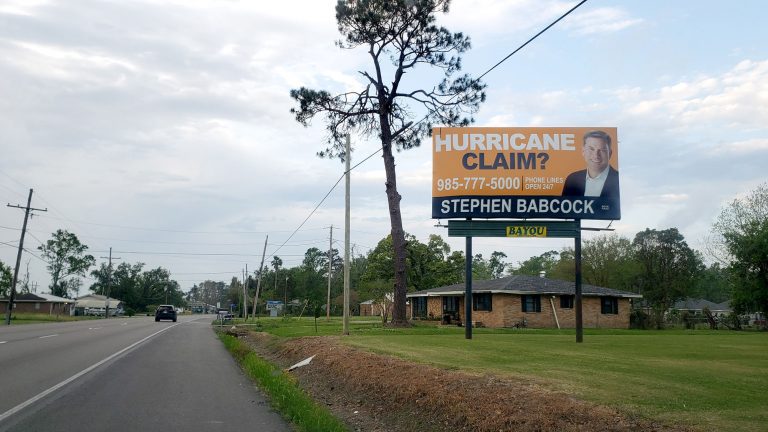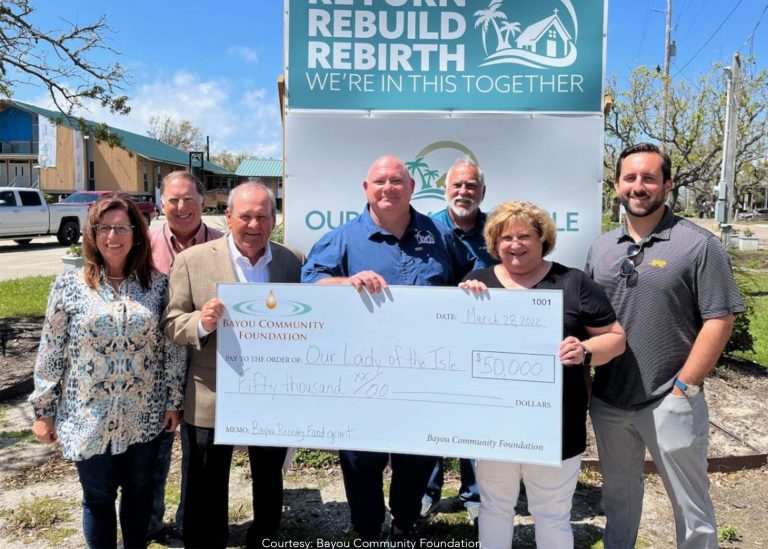by Karly Taranto, staff writer
Grand Isle is home to about 1,460 people, many of whom are still recovering from Hurricane Ida’s devastation. It is also a second home for many camp owners, some of whom say they are debating whether to rebuild or demolish.
“We had about $80,000 in wind insurance, but rebuilding would cost over $250,000 with the cost of materials,” says camp owner Paul Hymel.
Hymel says he co-owned the camp with his brother, two uncles and grandmother. Following the hurricane, only the foundation stood in the place of what he says was once a second home for his family.
“My uncles and grandmother do not have much interest or need to have a camp there, so that leaves my brother and I to do anything with it,” says Hymel. “We just don’t have the time to do the construction and, frankly, do not have the know-how or people who could help us; not mentioning the cost it would take us to rebuild.”
The Federal Emergency Agency (FEMA) has strict requirements regarding the rebuilding process. A new policy requires coastal structures to be built 16 feet above the ground to protect them from wave and flood damage during natural disasters. The homes that did not meet the required elevation received less insurance money for the property destruction from Hurricane Ida.
The Hymel family’s camp is a 1950’s home that was elevated to 10 feet and has not been remodeled. Because of increased insurance costs due to their camp being below elevation requirements, the only insurance the family could afford was wind insurance. However, they did not receive enough money to consider rebuilding.Following the aftermath of Hurricane Ida, new building codes are being implemented. Height requirements and wind-proof building materials are now required, and insurance costs will increase for homeowners on the island.
Insurance adjusters are assessing homes to determine if rebuilding or repairing will be required for each home. If adjusters deem that a house is over 50 percent damaged, owners will be required to demolish.
“Because of the extent of damage, building codes becoming more stringent and cost of materials rising, I think you will see a lot more selling rather than rebuilding,” says insurance agent Chris Hogan. “The building codes will require more money, which will make it harder for people who own camps to rebuild on the island, especially if starting from scratch.”
Though organizations like the Bayou Community Foundation have raised over $4,000,000 to contribute to rebuilding and recovery, the significant increase in general building costs will leave an abundance of empty lots in Grand Isle.
Hymel says many camp owners who were left with nothing have discussed putting awnings on their property and bringing campers to the island instead of rebuilding.
“Options for us would be purchasing an older camp or rebuilding; either way it is extremely expensive or not worth it due to the risks of natural disasters in the future,” says Hymel. “Lots of memories were made on the island in our camp that no longer exists.”

Insurance Challenges
By Jonathan Eastwood, features editor Many Grand Isle residents that survived Hurricane Ida are now faced with rebuilding damaged houses and camps. But, for some, insurance is not paying enough to cover the cost of damages, leading them to take legal action. “I used to live at our camp, and it was a beautiful camp,” says Dane Baker, whose family camp on Grand Isle was severely damaged in the storm. Baker said his family’s property received upwards of $40,000 in damages, but insurance was only willing to pay $2,000. He says because of this, the camp will have to be demolished. “The insurance is doing us dirty,” Baker says. “We’re probably gonna have to knock down our camp completely because we’re not gonna have the money to fix it. It really makes me sad – it makes me so sad to be treated this way by the insurance company and have to just destroy the thing I love so much.” “The insurance is doing us dirty. It makes me so sad to be treated this way by the insurance company and have to just destroy the thing I love so much.” — Dane Baker, camp owner Michael Johnson, a public building consultant, says he inspected a home in Grand Isle that sustained enough damage to shift the building on its foundation. However, its owners still received insurance estimates lower than necessary to fix the damage. “This particular one, I’ve already written the estimate on it,” says Johnson. “My estimate was three times more than her [insurance] estimate.” Some are taking legal action against their insurance companies. Attorneys are reaching out to help the public with their claims. At a public meeting for those curious about moving forward with claims against their insurance companies, attorney Michael Moore presented a scenario that may take place if legal action is not taken. “It’s been 193 days since Hurricane Ida hit – we shouldn’t be having this conversation right now,” Moore says. “But the scarier number is that it’s been 560 days since [Hurricanes] Laura and Delta hit Lake Charles and it’s still nothing but blue tarps [on the roofs].” Attorney Beau Brooks says he heard stories of insurance companies refusing to contact their clients whose homes were in unlivable conditions. This is not only localized to Grand Isle, but much of South Louisiana, says Brooks. “It doesn’t matter if you’re in Grand Isle, if you’re in Cutoff, or if you’re in Larose – you’re just seeing a lot of people continuing to have problems with their insurance companies paying,” says Brooks. Baker’s grandmother recently began legal proceedings against the family’s wind insurance provider to seek the compensation she says they are owed. “There’s no reason why you pay a company for years and years, give them tens of thousands of dollars, and then they don’t wanna help you out at all,” Baker says. “That’s just plain wrong.”Some people with property on the island say they received adequate payment from the start and do not need to seek legal action, but they also acknowledge the trouble others currently face. “Some people did good, some people had to get lawyers,” says Donnie Camardelle, a Grand Isle camp owner. “There might be two out of 10 [that are] satisfied.” Hellickson Public Adjusting sign in Grand Isle Babcock billboard on Hwy-24 Baldone billboard Hwy-24 Legal meeting Attorney Beau Brooks’s meeting at Politz’s in Thibodaux. St. Martin-Bourque Billboard on Hwy-24

Aid to Help Island Recovery
By Karly Taranto, staff writer The Recovery from Hurricane Ida’s devastation has been ongoing since the day after landfall for the Islanders. There has been an abundance of helping hands from different groups across the state. The Bayou Community Foundation (BCF) began awarding assistance grants in October 2021, so far totaling $4,365,918 in aid relief. Jennifer Armond, coordinator of the Bayou Community Foundation (BCF), says grants will continue to be awarded as they become available. Grants through the BCF are not limited to rebuilding purposes only. They also provide hot meals, supplies, and financial assistance to help families in need. There is a lack of housing on the Island even though it has been 7 months since the hurricane. Many families are relocated, but slowly returning to Grand Isle. “We are working on a larger housing effort for Grand Isle right now,” Armond says. Physical support like this was needed to get Grand Isle back up and running, but assistance for families was also necessary during what was, to many, an emotional time. Families lost jobs and income to provide for themselves and their families. “It was amazing to see the generosity of other home and camp owners on the island after everything was said and done, it was a very emotional experience.” — Michelle Wool, camp owner Janet Scardino, Mayor’s Assistant in Grand Isle, says The Benson Charitable Foundation reached out to us in regards to bringing toys here for the kids around Christmas time. The Benson Foundation is a charitable foundation from New Orleans, founded by Tom and Gayle Benson. “They came in with truck loads of toys for the kids here; we put out the toys on tables for the kids to choose from and we still had crates of toys left over, it was amazing,” says Scardino. “There were toys ranging from wireless headphones for the older kids to nice backpacks from Disney World.” The town of Grand Isle experienced additional help that played a significant role for them getting back onto the island following the devastation from Hurricane Ida. Family and friends worked together to pick up debris at camps and houses. They brought water and food to people who needed it. “As we cleaned what was left of our camp shortly after the hurricane, we had at least 10 to 12 people stop and offer a hand in our cleaning process; along with anything else we could possibly need,” says camp owner Michelle Wool. Alternative to money, manual labor assistance was provided for demolitions. Many people from other areas of Louisiana traveled to the island to offer help in cleaning up, along with helping to salvage what was able to be saved. The National Guard helped clear roads and debris from the Island immediately following the storm. Other organizations such as Catholic Charities, United Houma Nation, and the Cajun Navy assisted Grand Isle, as well. “I believe we partner with organizations to make a difference in our local community, but also to make a bigger impact across South Louisiana,” says Sherry Rhodes with Catholic Charities. The people of Grand Isle stay hopeful that assistance will continue to come as they recover from the natural disaster. Wool says, “It was amazing to see the generosity of other home and camp owners on the island after everything was said and done, it was a very emotional experience.” https://youtu.be/UEXrVy7tcRI
